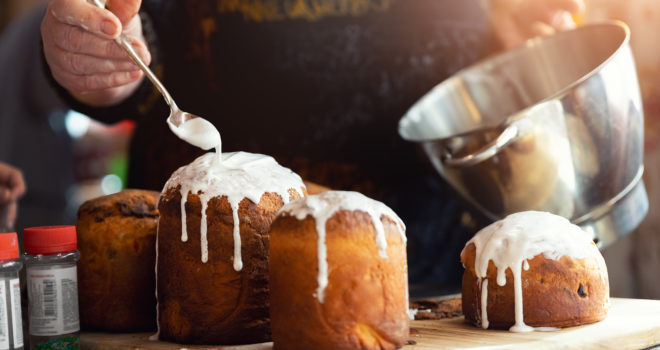Holy Week—feast or fast? Both. For Catholics, fasting means maintaining Lenten obligation to enjoy one normal meal a day. Fasting becomes more rigorous after the special Maundy Thursday dinner—the Last Supper—which for some replicates Christ’s last meal. That would be a Seder meal with wine, unleavened bread, and a lamb shank, plus other offerings. This feast also commemorates Christ’s institution of the Holy Eucharist.
From Good Friday to Easter Sunday—the Triduum—fasting helps encourage hunger of the body and hunger of the spirit for redemption. But Easter Sunday is a special day in the Christian calendar when all celebrate the risen Christ after His crucifixion. Thus, Easter has become a day of feasting and socializing after attending Mass.
And for many, Easter Sunday is the time to break the Lenten fast and enjoy such typical offerings as baked ham or roasted chicken, baked or mashed potatoes, peas, rolls, and desserts that might include cheesecake or a lamb cake. But there are so many other options, so check out these recipes and start feasting Easter Sunday.
Mexican-Style Hummus
Serves 4
Inspired by its Mediterranean version, this bean dip makes a great cocktail time offering or first course. It’s best served with tortilla chips or cut-up fresh vegetables.
- One 15.5-oz. can pinto beans, drained and rinsed
- ½ cup mild salsa
- 1 tablespoon fresh lime juice
- 1 tablespoon olive oil
- 1 teaspoon minced garlic
- 1 teaspoon ground cumin
- ½ cup toasted pumpkin seeds
- ½ cup chopped cilantro
Put beans, salsa, lime juice, olive oil, garlic, and cumin in food processor or blender, and purée until smooth. Spoon the mixture into bowl, and stir in pumpkin seeds and cilantro. Use immediately, or cover and refrigerate.
Gazpacho
Serves 4
This classic cold Spanish soup that many believe originated in Andalusia may have its origins in ancient Roman times. The soup’s name itself may have devolved from Greek, Israeli, Latin, or Moorish cooks.
Once made by combining hand-chopped vegetables, gazpacho now comes together quickly by using a blender or food processor. Although these ingredients are traditional, the cook can adjust which to eliminate and the quantities to suit one’s taste. And one Andalusian source once said: “De gazpacho no hay empacho—there’s never too much gazpacho.”
- 4 to 5 whole ripe tomatoes, stem end removed and quartered
- 1 cucumber, peeled and chopped
- 1 onion, peeled and chopped
- 1 green pepper, seeded and chopped
- 3 cloves garlic, peeled and chopped
- 2 to 3 tablespoons olive oil, or more as needed
- 1 tablespoon cider vinegar
- Salt and freshly ground black pepper to taste
- Chopped scallions for garnish
- Cubed green peppers for garnish
- Bread cubes for garnish
Combine tomatoes, cucumber, onion, green pepper, garlic, olive oil, vinegar, salt and pepper in a food processor or blender, and pulse until mixture is smooth. Pour the soup into serving bowls, and garnish with scallions, green peppers, and bread cubes.
Herb-Coated Rack of Lamb
Serves 4
For lamb
- 2 (8-rib) frenched racks of lamb (each rack 1 1/2 lb), trimmed of all but a thin layer of fat
- 1 1/2 teaspoons salt
- 3/4 teaspoon black pepper
- 1 teaspoon vegetable oil
For herb coating
- 1/2 head new garlic or 3 large regular garlic cloves, minced
- 1/4 cup finely chopped fresh flat-leaf parsley
- 1 tablespoon finely chopped fresh thyme
- 2 teaspoons finely chopped fresh rosemary
- 1/2 teaspoon salt
- 1/2 teaspoon black pepper
- 1 1/2 tablespoons extra-virgin olive oil
- Special equipment: an instant-read thermometer
Directions:
1. Preheat the oven to 350 degrees with a rack in the middle. Stir together garlic, herbs, salt, pepper, and oil, and set aside.
2. Brown the lamb by heating a 12-inch skillet over high heat until hot. Meanwhile, pat lamb dry and rub meat all over with salt and pepper. Add oil to hot skillet, then brown lamb racks in 2 batches, if necessary, on all sides, about 10 minutes per batch.
3. Coat meaty parts of lamb with herb mixture, pressing to help adhere. Roast the lamb for 15 minutes, then cover the lamb loosely with foil and roast until thermometer inserted diagonally into center of meat registers 120°F, 5 to 10 minutes more. Let stand, covered, 10 minutes. (Internal temperature will rise to 125 to 130°F for medium-rare while lamb stands.)
4. Remove from the oven, and cut each rack into 4 double chops. Serve hot.
Clapshot
This is a very typical Scottish vegetable dish, made with potatoes and turnips. It originated in Orkney or Northern Scotland, and traditionally was made with bacon fat, not butter. The best version calls for very starchy potatoes; the traditional name for a potato is “tattie.” (Recipe credit: Michele Ritchey-Moore; permission The Gresham Publishing Company Limited, Glasgow, Scotland)
Serves 4
- 1 pound potatoes, peeled
- 1 pound turnips, peeled and chopped
- 3 tablespoons unsalted butter
- 1 onion, peeled and diced
- 2 tablespoons chopped chives
- Salt and freshly ground black pepper to taste
Cook the potatoes and the turnips separately in boiling water until fork tender. Meanwhile, heat 2 tablespoons butter over medium heat, and cook the onion, stirring until soft but not browned. When the potatoes and turnips are tender, drain, and combine in a large bowl. Using a fork or potato masher, mash the two together with the remaining butter and the fried onions. Once well combined, stir in the chives and season to taste. Serve hot.
Garlic and Cheese Mashed Potatoes
(Recipe credit, Virginia farmer Teri Guevremont, in the cookbook Cooking with the Saints, published by Sophia Institute Press)
Serves 6
- 2 pounds Yukon gold potatoes, peeled and quartered length-wise
- 1/2 teaspoon salt
- 6 tablespoons heavy cream
- 3 tablespoons unsalted butter
- 2 cloves crushed garlic
- 1 cup grated Cheddar cheese
- 2 tablespoons milk, or more as needed to smooth the potatoes
- Salt and freshly ground black pepper to taste
Put the potatoes into a large saucepan and add 1/2 teaspoon salt. Cover the potatoes with water, bring to a boil over medium heat, and reduce the heat to low. Cook, covered for 20 minutes or until fork tender.
Meanwhile, warm the cream and butter together. Drain the water from the potatoes, return the pot to the burner, and steam off any remaining water. Put the potatoes into a bowl, add the cream and butter, and mash with a potato masher. Stir in the cheese, milk and salt and pepper, using a wooden spoon.
Zucchini and Yellow Squash Piccata
(Recipe credit, Virginia farmer Teri Guevremont, in the cookbook Cooking with the Saints, published by Sophia Institute Press)
Serves 4 to 6
- 2 tablespoons olive oil
- 1 large onion, peeled and diced
- 2 zucchini, cubed
- 2 yellow squash, cubed
- 1 tomato, chopped
- About ¼ cup chicken broth or white wine to steam squash
- ¼ cup chopped parsley
- Pinch sage
- Pinch rosemary
- Pinch thyme
- Salt and freshly ground black pepper to taste
Heat the oil in a large skillet over medium heat, and sauté the onion until translucent. Add the zucchini, yellow squash, and tomatoes, and stir well. Add just enough chicken broth to help steam the vegetables until tender. Stir in the parsley, sage, rosemary, thyme, and salt and pepper. Serve hot or at room temperature.
Red, Red Salad
This chopped salad indulges your whim for something red and colorful for spring and summer eating. You can dress this with an oil and balsamic vinegar mixture, or any other preferred dressing.
Serves 6
- 1 bunch radishes, greens removed, trimmed and quartered
- 1/2 head red cabbage, cored and chopped
- 1 cup grape tomatoes
- 2 1/2 cups red kidney beans, drained and rinsed
- 1 large red bell pepper, seeded and diced
- 1/2 large red onion, diced
- Salt and freshly ground black pepper to taste
- Salad dressing to taste
Put all vegetables and beans in a large salad bowl, and season with salt and pepper. Dress with salad dressing, toss and serve.
Cheddar Scones
(adapted from King Arthur Flour)
Makes 12 scones
- 3 cups all-purpose flour plus extra for dusting
- 1 tablespoon baking powder
- 1 tablespoon sugar
- ½ teaspoon baking soda
- ½ teaspoon salt
- ¼ pound (1 stick) cold unsalted butter, diced
- 1 egg, beaten lightly
- 1 cup buttermilk
- 1 cup grated extra-sharp yellow cheddar
- 1 egg beaten with 1 tablespoon water or milk, for egg wash
Preheat the oven to 450 degrees F. Line a baking sheet with parchment paper.
Combine the 3 cups flour, the baking powder, baking soda, and salt in a mixing bowl. Add the butter and using a pastry blender or fingertips, rub it into the flour until the mixture looks like breadcrumbs. Stir in the shredded cheese. Beat together the egg and buttermilk, and quickly stir this into the flour mixture in about 20 seconds. The dough will be somewhat sticky.
Dump the dough onto a well-floured surface and knead it very gently about 10 times, or just enough to bring it together. Divide the dough in half. With well-floured hands, pat out each half into a 6-inch circle about ½-inch thick. Cut each dough circle into 6 wedges each. Place the wedges on the parchment paper, and brush the tops with the egg wash.
Bake the scones about 15 minutes, or until the tops turn golden. Remove from the oven and eat hot or warm.
Rose Jam Cookies
This recipe was adapted from a recipe found at The Joy of Soup. It was featured in a is part of the “Cooking with our Saints” series at St. Veronica Roman Catholic Church in Chantilly, VA. Makes 18-20.
For the filling
- ½ cup unsalted butter
- 1/3 cup granulated sugar
- 1 large egg, well beaten
- ¾ cup all-purpose flour
- Rose jam, as needed
- For the icing:
- 1 tablespoon rose jam, or more as needed
- 2 cups confectioners’ sugar
- Rose water, as needed
- Pinch salt
Preheat the oven to 350 degrees. Grease 2 baking sheets. Flour a work surface.
Using an electric mixer combine and mix all ingredients well, adding the jam last. Transfer onto the floured surface and knead until smooth. Roll into a ball and refrigerate 3 to 4 hours.
Roll the dough out on the floured surface about 1/8-inch thick. Using a 2 ½-inch round cookie cutter cut out as many cookies as you can. With a tiny cookie cutter cut out a shape in the center of half the cookies. You can either bake the tiny cut outs, or add them back to your dough.
Place cookies on the prepared baking sheets. Bake for about 8 minutes. Remove from the oven and cool completely. Cover each whole circle lightly with the rose jam. Top with a cookie that has a cut-out shape. Combine the confectioners’ sugar, enough rose water to make it spreadable, and the salt. Ice the top of the cookies, avoiding the cut-out portions.
Paska
Also known as Pashka, from the Russian word for Easter, this elegant Russian or Eastern Orthodox dessert is traditionally shaped to resemble the cave or “truncated pyramid” representing the cover over Christ’s tomb. Some countries also call their elegant Easter bread paska.
To make the Russian dessert, special wooden molds are often used for making this dessert, but a two-quart clay flowerpot, moistened and then double-lined with moistened cheesecloth, works just fine. Cooks can also use an old-fashioned Christmas pudding bowl.
Serves 6 to 8
- Four 8-ounce packages cream cheese, at room temperature
- 1 cup unsalted butter, at room temperature
- 2 cups confectioner’s sugar, sifter
- 3 egg yolks
- 2 teaspoons vanilla extract, or more to taste
- ¾ cup slice almonds
- Candied fruit and lemon peel, to taste
- Whole hulled strawberries as garnish
- One 2-quart clay flower pot or other paska container
- Cheesecloth
Combine the cream cheese and butter in a large mixing bowl, and with an electric beater blend them until smooth and well combined. Add the confectioner’s sugar, egg yolks, and vanilla, and blend again. Fold in the almonds and candied fruit and lemon peel. Set aside.
Line a moistened flower pot with double layers of moistened cheesecloth. Scoop in the mixture, cover with plastic wrap, and place a weight on top. Refrigerate for 48 hours.
To serve, gently extract the firm pashka from the flower pot or mold, and unwrap it. Place it on a serving dish, and garnish the dish and paska with the strawberries.
✠












